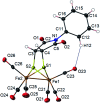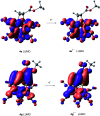Revisiting the photochemical synthesis of [FeFe]-hydrogenase mimics: reaction optimization, mechanistic study and electrochemical behaviour
- PMID: 35518225
- PMCID: PMC9056276
- DOI: 10.1039/d0ra06002j
Revisiting the photochemical synthesis of [FeFe]-hydrogenase mimics: reaction optimization, mechanistic study and electrochemical behaviour
Abstract
The photoreaction of [(μ-S)2Fe2(CO)6] and alkenes or alkynes has been optimized to readily obtain functionalized [FeFe]-hydrogenase mimics. Irradiation under low CO pressure in THF produces the corresponding photo-adducts in good/acceptable (alkenes/alkynes) yields, with retention of the starting olefin stereochemistry. DFT-calculations provide plausible reaction pathways in both, singlet and triplet states. The DFT-calculation based in the singlet state is energetically more favorable. The electrochemical behavior of the synthesized compounds is also presented, including studies in acidic media. The electrochemical properties of the products vary in the presence of a double bond (cycloaddition of [(μ-S)2Fe2(CO)6] to alkynes), respect to a single bond (cycloaddition to alkenes).
This journal is © The Royal Society of Chemistry.
Conflict of interest statement
The authors declare no competing financial interest.
Figures
















Similar articles
-
Triazole-Containing [FeFe] Hydrogenase Mimics: Synthesis and Electrocatalytic Behavior.Inorg Chem. 2019 Dec 2;58(23):16267-16278. doi: 10.1021/acs.inorgchem.9b02813. Epub 2019 Nov 13. Inorg Chem. 2019. PMID: 31721561
-
DFT/TDDFT exploration of the potential energy surfaces of the ground state and excited states of Fe2(S2C3H6)(CO)6: a simple functional model of the [FeFe] hydrogenase active site.J Phys Chem A. 2009 May 14;113(19):5657-70. doi: 10.1021/jp809347h. J Phys Chem A. 2009. PMID: 19378958
-
Probing the performance of DFT in the structural characterization of [FeFe] hydrogenase models.J Comput Chem. 2025 Jan 5;46(1):e27515. doi: 10.1002/jcc.27515. Epub 2024 Oct 17. J Comput Chem. 2025. PMID: 39417365
-
Synthesis, structure, and electrocatalysis of diiron C-functionalized propanedithiolate (PDT) complexes related to the active site of [FeFe]-hydrogenases.Inorg Chem. 2008 Jun 2;47(11):4545-53. doi: 10.1021/ic701982z. Epub 2008 Apr 26. Inorg Chem. 2008. PMID: 18439002
-
Approaches to efficient molecular catalyst systems for photochemical H2 production using [FeFe]-hydrogenase active site mimics.Dalton Trans. 2011 Dec 28;40(48):12793-800. doi: 10.1039/c1dt11166c. Epub 2011 Oct 10. Dalton Trans. 2011. PMID: 21983599 Review.
Cited by
-
Magnetic nanoparticle-supported eosin Y salt [SB-DABCO@eosin] as an efficient heterogeneous photocatalyst for the multi-component synthesis of chromeno[4,3-b]chromene in the presence of visible light.RSC Adv. 2022 Oct 11;12(45):28886-28901. doi: 10.1039/d2ra05122b. eCollection 2022 Oct 11. RSC Adv. 2022. PMID: 36320743 Free PMC article.
-
Heteropolymetallic [FeFe]-Hydrogenase Mimics: Synthesis and Electrochemical Properties.Inorg Chem. 2023 Feb 27;62(8):3409-3419. doi: 10.1021/acs.inorgchem.2c03355. Epub 2023 Feb 13. Inorg Chem. 2023. PMID: 36780261 Free PMC article.
-
One-pot multicomponent green LED photoinduced synthesis of chromeno[4,3-b]chromenes catalyzed by a new nanophotocatalyst histaminium tetrachlorozincate.RSC Adv. 2021 Jun 1;11(32):19723-19736. doi: 10.1039/d1ra00189b. eCollection 2021 May 27. RSC Adv. 2021. PMID: 35479251 Free PMC article.
-
Electrocatalytic Behavior of Tetrathiafulvalene (TTF) and Extended Tetrathiafulvalene (exTTF) [FeFe] Hydrogenase Mimics.ACS Org Inorg Au. 2021 Sep 13;2(1):23-33. doi: 10.1021/acsorginorgau.1c00011. eCollection 2022 Feb 2. ACS Org Inorg Au. 2021. PMID: 36855407 Free PMC article.
References
-
- Hydrogen as a Fuel: Learning from Nature, ed. R. Cammack, M. Frey and R. Robson, Taylor&Francis, 2001
- Compendium of Hydrogen Energy Volume 1: Hydrogen Production and Purification, ed. V. Subramani, A. Basile and T. N. Veziroğlu, Elsevier, 2015
- Dincer I. and Zamfirescu C., Sustainable Hydrogen Production, Elsevier, 2016
- Compendium of Hydrogen Energy Volume 4: Hydrogen Use, Safety and the Hydrogen Economy, ed. M. Ball, A. Basile and T. N. Veziroğlu, Elsevier, 2016
- Corredor J. Rivero M. J. Rangel C. M. Gloaguen F. Ortiz I. J. Chem. Technol. Biotechnol. 2019;94:3049–3063. doi: 10.1002/jctb.6123. - DOI
-
-
See, for example:
- Reisner E. Powell D. J. Cavazza C. Fontecilla-Camps J. C. Armstrong F. A. J. Am. Chem. Soc. 2009;131:18457–18466. doi: 10.1021/ja907923r. - DOI - PubMed
- Brown K. A. S. Dayal S. Ai X. Rumbles G. King P. W. J. Am. Chem. Soc. 2010;132:9672–9680. doi: 10.1021/ja101031r. - DOI - PubMed
- Brown K. A. Wilker B. Boehm M. Dukovic G. King P. W. J. Am. Chem. Soc. 2012;134:5627–5636. doi: 10.1021/ja2116348. - DOI - PubMed
- Honda Y. Hagiwara H. Ida S. Ishihara T. Angew. Chem. Int. Ed. 2016;55:8045–8048. doi: 10.1002/anie.201600177. - DOI - PubMed
-
-
-
Revisions:
- Schilter L. Camara J. M. Huynh M. T. Hammes-Schiffer S. Rauchfuss T. B. Chem. Rev. 2016;116:8693–8749. doi: 10.1021/acs.chemrev.6b00180. - DOI - PMC - PubMed
- Li Y. Rauchfuss T. B. Chem. Rev. 2016;116:7043–7077. doi: 10.1021/acs.chemrev.5b00669. - DOI - PMC - PubMed
- Gloaguen F. Inorg. Chem. 2016;55:390–398. doi: 10.1021/acs.inorgchem.5b02245. - DOI - PubMed
-
Representative examples:
- Li H. Rauchfuss T. B. J. Am. Chem. Soc. 2002;124:726–727. doi: 10.1021/ja016964n. - DOI - PubMed
- Na Y. Pan J. Wang M. Sun L. Inorg. Chem. 2007;46:3813–3815. doi: 10.1021/ic070234k. - DOI - PubMed
- Gao S. Fan J. Sun S. Peng X. Zhao X. Hou J. Dalton Trans. 2008:2128–2135. doi: 10.1039/B717497G. - DOI - PubMed
- Li P. Wang M. Chen L. Liu J. Zhao Z. Sun L. Dalton Trans. 2009:1919–1926. doi: 10.1039/B814336F. - DOI - PubMed
- Apfel U.-P. Troegel D. Halpin Y. Tschierlei S. Uhlemann U. Görls H. Schmitt M. Popp J. Dunne P. Venkatesan M. Coey M. Rudolph M. Vos J. G. Tacke R. Weigand W. Inorg. Chem. 2010;49:10117–10132. doi: 10.1021/ic101399k. - DOI - PubMed
- Camara J. M. Rauchfuss T. B. Nat. Chem. 2012;4:26–30. doi: 10.1038/nchem.1180. - DOI - PMC - PubMed
- Zheng D. Wang M. Chen L. Wang N. Sun L. Inorg. Chem. 2014;53:1555–1561. doi: 10.1021/ic4025519. - DOI - PubMed
- Yu T. Zeng Y. Chen J. Li Y.-Y. Yang G. Li Y. Angew. Chem. Int. Ed. 2013;52:5631–5635. doi: 10.1002/anie.201301289. - DOI - PubMed
-
-
-
An alternative route to incorporate moieties II and III in substrates incompatible with the standard synthetic approaches to these compounds is the use of Fe2[(μ-SCH2)2(NC6H4N3)](CO)6 reagents through a Cu-catalyzed alkyne-azide cycloaddition. See,
- Merinero A. D. Collado A. Casarrubios L. Gómez-Gallego M. Ramírez de Arellano C. Caballero A. Zapata F. Sierra M. A. Inorg. Chem. 2019;58:16267–16278. doi: 10.1021/acs.inorgchem.9b02813. - DOI - PubMed
-
LinkOut - more resources
Full Text Sources
Research Materials

